Giftedness and Talent in the 21st Century
2739-giftedness-and-talent-in-the-21st-century
2739-giftedness-and-talent-in-the-21st-century
You also want an ePaper? Increase the reach of your titles
YUMPU automatically turns print PDFs into web optimized ePapers that Google loves.
PREVIEWING A COLLABORATIVE EXPLORATION OF GIFTED EDUCATION<br />
<strong>and</strong> talented <strong>in</strong> Europe <strong>and</strong> North America when it comes to <strong>the</strong> discovery <strong>and</strong><br />
development of aspirations <strong>and</strong> talents? (Sheyla Blumen, Chapter 9)<br />
• Can <strong>the</strong> organizations of <strong>the</strong> <strong>21st</strong> century dismantle stereotypes that suppress<br />
<strong>the</strong> development of creative <strong>in</strong>telligence <strong>and</strong> underm<strong>in</strong>e efforts to engage <strong>in</strong><br />
productive <strong>in</strong>novation? (Mary Jacobsen, Chapter 10)<br />
• Can we help gifted young people discover stronger senses of empowerment,<br />
ethics, <strong>and</strong> connection with o<strong>the</strong>rs that will help <strong>the</strong>m overcome <strong>the</strong> excessive<br />
materialism <strong>and</strong> <strong>in</strong>dividualism of today’s Western culture? (Dorothy Sisk,<br />
Chapter 11)<br />
• Will gifted education be able to developed autonomous learners, complex th<strong>in</strong>kers,<br />
<strong>and</strong> problem solvers who can <strong>in</strong>tegrate <strong>the</strong>ir cognitive, social, emotional, <strong>and</strong><br />
physical capacities <strong>in</strong> complex <strong>21st</strong> century conditions? (George Betts, Blanche<br />
Kapushion, <strong>and</strong> Rob<strong>in</strong> Carey, Chapter 12)<br />
• To what extent can gifted learners develop higher-level th<strong>in</strong>k<strong>in</strong>g skills <strong>and</strong><br />
<strong>in</strong>cl<strong>in</strong>ations for <strong>in</strong>tegrat<strong>in</strong>g learn<strong>in</strong>g from differ<strong>in</strong>g subject areas <strong>in</strong> order to<br />
address today’s real-world problems? (Joyce VanTassel-Baska, Chapter 13)<br />
• Are educators of <strong>the</strong> gifted able to identify <strong>the</strong> different types of learners <strong>and</strong><br />
adjust <strong>the</strong>ir talent development to m<strong>in</strong>imize <strong>the</strong> gap between <strong>the</strong>ir potential<br />
<strong>and</strong> actual performance so <strong>the</strong>y have <strong>the</strong> best opportunities for success <strong>in</strong> <strong>the</strong><br />
complexity of <strong>the</strong> <strong>21st</strong> century? (Seon-Young Lee, Chapter 14)<br />
• Are we able to help twice-exceptional <strong>in</strong>dividuals address <strong>the</strong>ir weaknesses while<br />
recogniz<strong>in</strong>g <strong>and</strong> emphasiz<strong>in</strong>g <strong>the</strong>ir strengths so <strong>the</strong>y can meet <strong>the</strong> dem<strong>and</strong>s of<br />
<strong>21st</strong>-century globalization? (Rick Olenchak, Laura Jacobs, Maryam Hussa<strong>in</strong>,<br />
Kelly Lee, <strong>and</strong> John Gaa, Chapter 15)<br />
Only a few of many possible questions are listed here, just enough to give you<br />
a sense of <strong>the</strong> <strong>in</strong>tellectual terra<strong>in</strong> our contributors chose to explore <strong>in</strong> efforts to<br />
<strong>in</strong>tegrate giftedness <strong>and</strong> talent development with <strong>21st</strong>-century globalization. We<br />
leave it to you to raise more questions as you make your way through <strong>the</strong> pages to<br />
come. Our hope is that this book will prompt readers to pay more attention to <strong>the</strong><br />
effects of large-scale contextual <strong>in</strong>fluences on <strong>the</strong>ir own work.<br />
AN OVERVIEW OF THE CONTENTS OF THE VOLUME<br />
This book <strong>in</strong>cludes four sections that connect much of what we know about<br />
giftedness <strong>and</strong> talent development with <strong>the</strong> challenges of <strong>21st</strong>-century globalization.<br />
The first section <strong>in</strong>troduces <strong>the</strong> project <strong>and</strong> provides an <strong>in</strong>terdiscipl<strong>in</strong>ary framework<br />
for analyses of globalization. The second section addresses conceptions of<br />
giftedness <strong>and</strong> talent development with<strong>in</strong> <strong>the</strong> context of globalization. Authors <strong>in</strong><br />
<strong>the</strong> third section come up with ways to make gifted education align better with <strong>21st</strong>century<br />
contextual <strong>in</strong>fluences. F<strong>in</strong>ally, section four represents <strong>the</strong> syn<strong>the</strong>sis of <strong>the</strong><br />
contributions <strong>in</strong> <strong>the</strong> volume.<br />
Our <strong>in</strong>troductory section titled Recogniz<strong>in</strong>g Powerful Contextual Influences<br />
on <strong>Giftedness</strong> <strong>and</strong> <strong>Talent</strong> Development, is comprised of this <strong>in</strong>troductory chapter<br />
7



